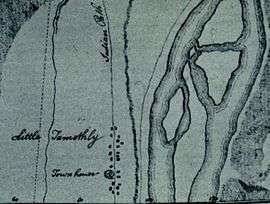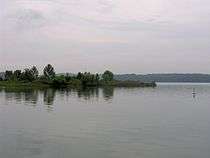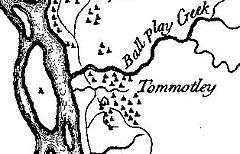Tomotley
|
Tomotley Site | |
|
Tomotley on Henry Timberlake's 1762 "Draught of the Cherokee Country" | |
| Location | Monroe County, Tennessee |
|---|---|
| Nearest city | Vonore |
| Coordinates | 35°34′13″N 84°11′10″W / 35.57028°N 84.18611°WCoordinates: 35°34′13″N 84°11′10″W / 35.57028°N 84.18611°W |
| Built | circa 1000 A.D., 1751 A.D. |
| NRHP Reference # | 78002617 |
| Added to NRHP | 1978 |
Tomotley (also known as Tamahli) is a prehistoric and historic Native American site in Monroe County, Tennessee, in the southeastern United States. Occupied as early as the Archaic period, the Tomotley site had the most substantial periods of habitation during the Mississippian period, likely when the earthwork mounds were built, and later during the mid to late eighteenth century as a refugee village of Cherokee from the Lower, Middle and Valley towns.
The Tomotley site is now submerged by Tellico Lake, an impoundment of the Little Tennessee River managed by the Tennessee Valley Authority. The site is visible from Toqua Beach and the Toqua Boat Ramp, both of which are managed by the Tennessee Wildlife Resources Agency.
Geographical setting
The Little Tennessee River traverses northern Monroe County for roughly 40 miles (64 km) between its Calderwood Lake impoundment near the Tennessee-North Carolina border and its mouth along the Tennessee River near Lenoir City. The impoundment of the river in 1979 by Tellico Dam created Tellico Lake, which covers the river's lower 33 miles (53 km) as well as the lower 22 miles (35 km) of its tributary, the Tellico River.[1] The Tomotley site was situated along the south bank of the Little Tennessee just north of the river's confluence with Toqua Creek,[2] nearly 22 miles (35 km) above the river's mouth along the Tennessee. The Overhill Cherokee village of Toqua and its associated prehistoric site was located on the south side of Toqua Creek, opposite Tomotley.
Toqua Beach and the Toqua Boat Ramp, which overlook the Tomotley site, are located along Tennessee State Route 360 (Citico Road), roughly 2 miles (3.2 km) south of the road's junction with U.S. Route 411 in Vonore.
Historical information

Etymology
The root of the name "Tomotley" is unknown, although it is generally believed to have originated before the Cherokee occupation. The ethnologist, James Mooney, suggested a possible Creek origin, pointing out the phonetic similarity to the Creek town of Tama'li, which was located on the Chattahoochee River in Georgia.[3] Others have theorized that Tomotley was formed by Lower and Valley town refugees fleeing warfare with the Creek in the mid-18th century, noting that the town name also appears among Lower and Valley Cherokee towns in South Carolina and North Carolina.[4]
Town history
Tomotley first appears in the European colonial historical record in 1756 under the governorship of Attakullakulla. That same year, a small English force under Captain Raymond Demeré arrived in the area to build and garrison Fort Loudoun. The garrison was greeted at Tomotley by Kanagatucko (Old Hop), who told Demeré, "I am now old and lie upon a bad bearskin. My life is not more than an inch long."[5] William de Brahm, who designed the fort, resided at Tomotley while the fort was being constructed in late 1756.[6]
Around this time, a sharp political rift occurred between pro-French and pro-English factions in the Cherokee hierarchy. When pro-French sentiments began to prevail in the key Overhill town of Great Tellico, its pro-English headman, Ostenaco, was forced to flee to the Little Tennessee Valley.[7] By the time Henry Timberlake visited the Little Tennessee Valley on his peace mission in 1761, Ostenaco was governor of Tomotley (Attakullakulla was listed as governor of nearby Tuskegee and Mialoquo).[8]
During the American Revolution and Cherokee–American wars, most of the Overhill towns were destroyed by American forces. Tomotley's location at a strategic ford along the Little Tennessee led to its being the first of the Overhill towns captured by William Christian's expedition in 1776.[9] When John Sevier invaded the valley three years later, he reported that Tomotley was still in ruins.[10]
Archaeological work at the Tomotley site

The first major archaeological investigation at the Tomotley site was conducted by J.W. Emmert of the Smithsonian Institution in the 1880s. Emmert located two mounds at the site, one of which was 8 feet (2.4 m) high and had a diameter of 58 feet (18 m). Both contained human burials.[11]
In anticipation of the inundation of the lower Little Tennessee Valley by the creation of Tellico Lake, the University of Tennessee Department of Anthropology (under contract with the National Park Service) surveyed the area in 1967. Test excavations were conducted at the Tomotley site that same year in an attempt to locate the historical village. As the Tellico Dam project stalled, the University of Tennessee was able to conduct more extensive excavations at Tomotley in 1973, 1974, and 1976. The excavations located 19 Cherokee and pre-Cherokee structures, including Tomotley's councilhouse, 18 human burials, and several thousand ceramic, stone, and bone artifacts.
While the site yielded evidence of Archaic and Woodland period occupation, excavation revealed that Tomotley's most substantial periods of habitation occurred during the Mississippian period (1000-1500 A.D.), when the mounds were built; and during the Overhill Cherokee period (18th century).[12] Excavations also uncovered a number of Euro-American artifacts, some of which may have originated with the Fort Loudoun garrison.[13]
Tomotley's Cherokee inhabitants
Prior to excavation, historians had thought that Tomotley was founded by refugees from the Cherokee Middle, Lower, or Valley towns when they fled warfare with the Creek and later the English, whose attacks destroyed their towns in the mid-18th century. The goals of the 1976 excavations were to shed light on this theory by determining the location and structure of Tomotley's councilhouse, analyzing Tomotley's Cherokee dwellings, and establishing the general layout of the village.[14]
The dwellings uncovered at Tomotley provided some of the strongest evidence of non-Overhill occupation. Of the 19 structures uncovered at Tomotley, one was octagonal (the council-house), and the rest were either square or rectangular in shape. The lack of circular structures was inconsistent with historical accounts of Overhill Cherokee dwellings, which typically consisted of a circular ("winter") house and a rectangular ("summer") house. Archaeological investigations at Overhill sites such as Toqua, Chota, and Citico uncovered substantial evidence of circular structures.
But, circular structures were not common among Lower and Valley towns. Other evidence supporting occupation by refugees from these areas includes the ceramic material uncovered during the 1973-1974 excavations. The artifacts bore more similarities to Middle and Chickamauga Cherokee (Lower Cherokee) ceramics than to Overhill ceramics.[15]
References
- ↑ Richard Polhemus, The Toqua Site — 40MR6 Vol. 1 (Knoxville, Tenn.: The Tennessee Valley Authority, 1987), 1.
- ↑ William Baden, Tomotley: An Eighteenth Century Cherokee Village (Knoxville, Tenn.: Tennessee Valley Authority, 1983), 1-9.
- ↑ James Mooney, Myths of the Cherokee and Sacred Formulas of the Cherokee (Nashville, Tenn.: C and R Elder, 1972), 534.
- ↑ Baden, Tomotley: An Eighteenth Century Cherokee Village, 10-29.
- ↑ Brewer, Alberta and Carson; Valley So Wild, Knoxville, Tennessee: East Tennessee Historical Society; 1975; p. 32.
- ↑ Carl Kuttruff, Beverly Bastian, Jenna Tedrick Kuttruff, and Stuart Strumpf, "Fort Loudoun in Tennessee: 1756-1760: History, Archaeology, Replication, Exhibits, and Interpretation," Report of the Tennessee Wars Commission and Tennessee Division of Archaeology, Research Series No. 17 (Waldenhouse Publishers, Inc., 2010), p. 37. Accessed at the Tennessee State Library and Archives website, 3 December 2013.
- ↑ Baden, Tomotley: An Eighteenth Century Cherokee Village, 10-29.
- ↑ Henry Timberlake, Samuel Cole Williams; Memoirs, 1756-1765; Marietta, Georgia; Continental Book Company; 1948; Pp. 57-58.
- ↑ J.G.M. Ramsey, The Annals of Tennessee (Johnson City, Tenn.: Overmountain Press, 1999), 168.
- ↑ Baden, Tomotley: An Eighteenth Century Cherokee Village, 10-29.
- ↑ Baden, Tomotley: An Eighteenth Century Cherokee Village, 30-31.
- ↑ Baden, Tomotley: An Eighteenth Century Cherokee Village, iv-vi.
- ↑ Linda Carnes, Tomotley: An Eighteenth Century Cherokee Village (Appendix II), 204-205.
- ↑ Baden, Tomotley: An Eighteenth Century Cherokee Village, 30-48.
- ↑ Baden, Tomotley: An Eighteenth Century Cherokee Village, 144-180.


